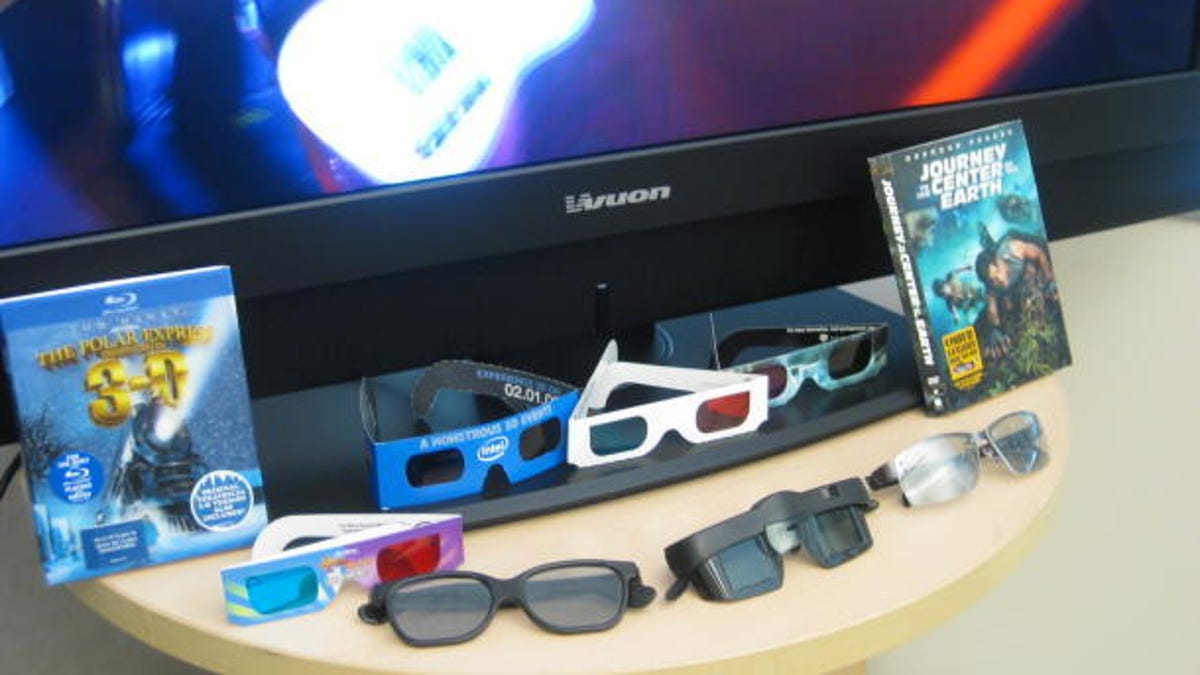One pair of 3D glasses to rule them all
A drawback of the nascent 3D technology for the home is competing brands of proprietary 3D glasses, but industry leaders are working on a solution.

The good news about the 3D TVs coming out this spring and summer is that they'll come packed with two pairs of 3D lenses. The bad news? Those plastic glasses work only with the brand of TV with which they're shipped.
That means that if you buy a Panasonic 3D TV, you can't use the accompanying lenses with your neighbor's Sony 3D TV, should you want to get together to watch the World Cup in 3D this summer. That's because each TV brand has a sensor that picks up a signal from the corresponding brand of glasses.
If that seems backwards, it's because it is. But it's also the sign of a new technology that hasn't yet worked out all of its kinks. Thankfully, the burgeoning 3D industry knows that this is a shortcoming and is concocting a fix.
One company that makes 3D eyewear, XpanD, has staked its claim to be the vendor of choice for brand-agnostic 3D glasses. The company has been manufacturing 3D glasses for movie theaters in Europe and Asia for years, and it is now moving to make the glasses work for people's homes as well.
XpanD has been contracted to produce the lenses that will ship with Panasonic and Vizio's 3D sets, but the company is also aiming more broadly: to be the provider of one pair of glasses that people buy once and use everywhere. XpanD's glasses will be available for between $125 and $150, starting June 1 at retailers such as Best Buy and Sears.
"The goal of the glasses is to work with every (size of) 3D display, from laptops to cinema," said Ami Dror, XpanD's chief strategy officer.
Dror says that would include all 3D televisions using infrared to communicate between the TV and the active-shutter 3D glasses. ("Active" glasses have battery-powered shuttering to allow the eyes to see 3D images, while "passive" glasses are the polarized lenses you get at the movie theater.) All major manufacturers--such as Sony, Samsung Electronics, and Panasonic--and most 3D-capable computer monitors and laptop screens--which gamers are expected to gravitate toward--use active-shutter glasses.
Dror anticipates the glasses being for sale in theaters or in retail stores alongside 3D displays. The way he sees it, people will want the option to choose their own glasses, especially if 3D-watching parties become popular.
Besides consumers being limited in how and when they can use their 3D glasses, XpanD believes that retailers can't be expected to stock glasses from every possible manufacturer on their shelves.
"At Best Buy, they carry 15, 20 models of TVs," Dror said. "We can't expect them to carry 15 types of 3D glasses. That doesn't make sense."
The competition
Gunnar Optiks, which makes glasses that reduce eyestrain induced by staring at a computer screen all day, has also said it plans to make universal 3D glasses. It's a great idea, but it's unclear that the technology has actually been tested yet. (Until CNET Labs gives them a spin, we'll reserve judgment.) In any case, what XpanD and Gunnar Optiks are trying to do is a necessary step in the evolution, if 3D is going to move from the cinema to the couch.
"It's great that XpanD wants to be the vendor of choice for universal 3D glasses," said David Wertheimer, CEO and executive director of the Entertainment Technology Center at the University of Southern California. "But it's an easy thing to say and a harder thing to get all the people [to] work together."
That's where the Consumer Electronics Association comes in. The industry trade group is acting as referee between competing brands to agree on a standard for 3D eyewear. Representatives from TV makers, cable and broadcasting companies, eyewear manufacturers, and others together are reviewing proposals for standards and hashing out what that standard should be--and which companies will eventually make the standard glasses. Although they've been officially meeting for several months, the idea first came up last year.
"It was just evident to everybody that glasses were going to be a part of this ecosystem, and noninteroperable glasses would hamper the overall growth of the market," said Brian Markwalter, vice president of technology and standards for the CEA.
They're currently studying making active-shutter glasses the default technology, which are the most popular right now with TV makers. But there are details still to be worked out, such as the effects of competing with other infrared devices already in the living room, including TV remote controls.
Markwalter said the group meets every two weeks and that it understands the urgency, since these TVs are already seeping out into the market.
"They do feel the pressure of the marketplace," he said. "The schedule they had talked about is trying to at least have it whittled down to a basic approach by May or June. They're meeting pretty regularly, moving along as aggressively as they can. "
Until then, 3D TV watching it isn't going to be a naturally social experience, the way standard 2D TV-watching is now, at least at first, while the likes of Sony and Panasonic race to get the technology to the marketplace. But it will get there eventually, USC's Wertheimer says.
"As with any new technology, you try to get it to market, and get people to use it and start giving you feedback. All of (the manufacturers) have their own glasses and their own TVs that can only interact together. They do that to take the variables out of the equation, so they control the experience consumers have with the television," Wertheimer said. "But the natural evolution of 3D TVs over time is for them to have interoperability with the glasses."

